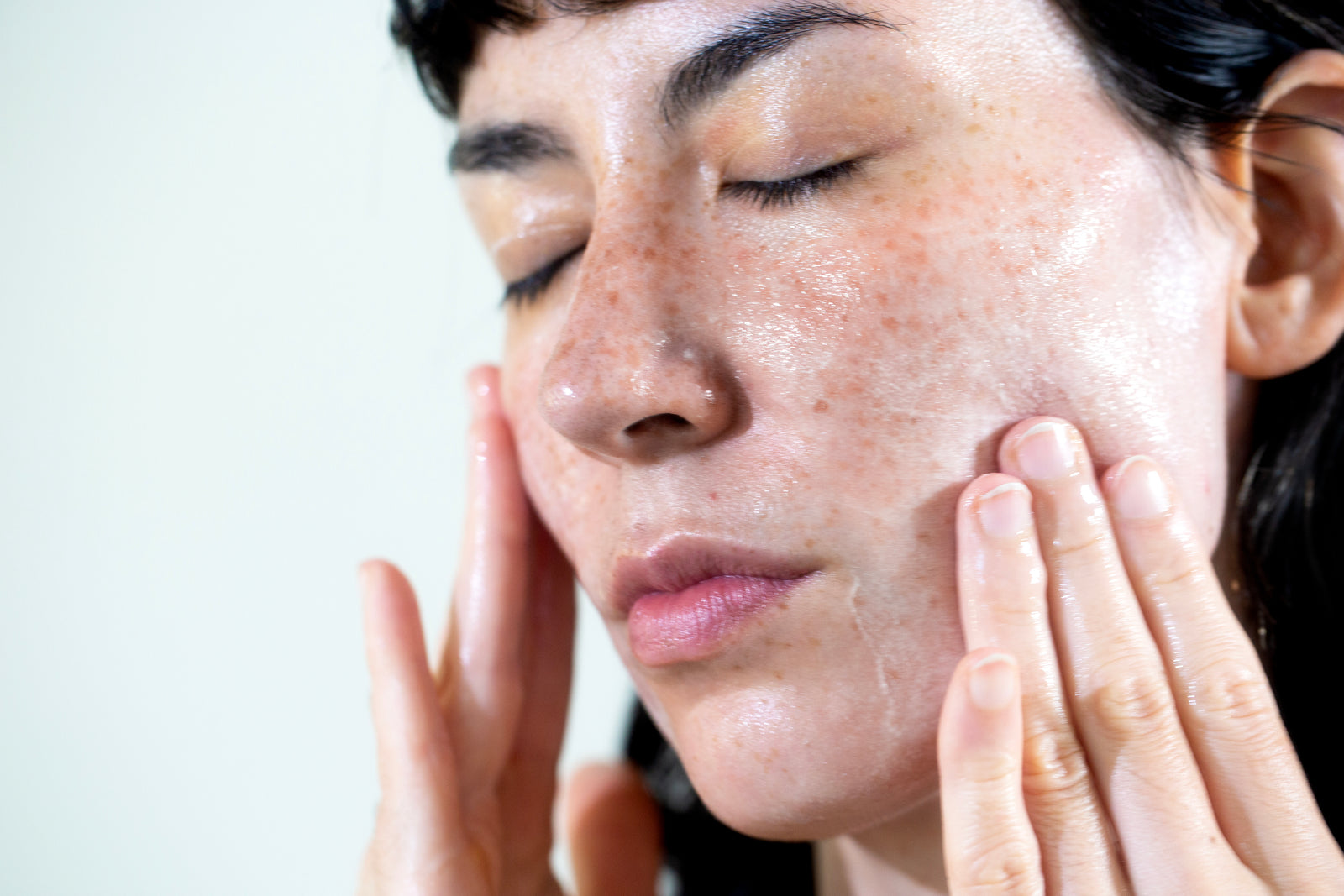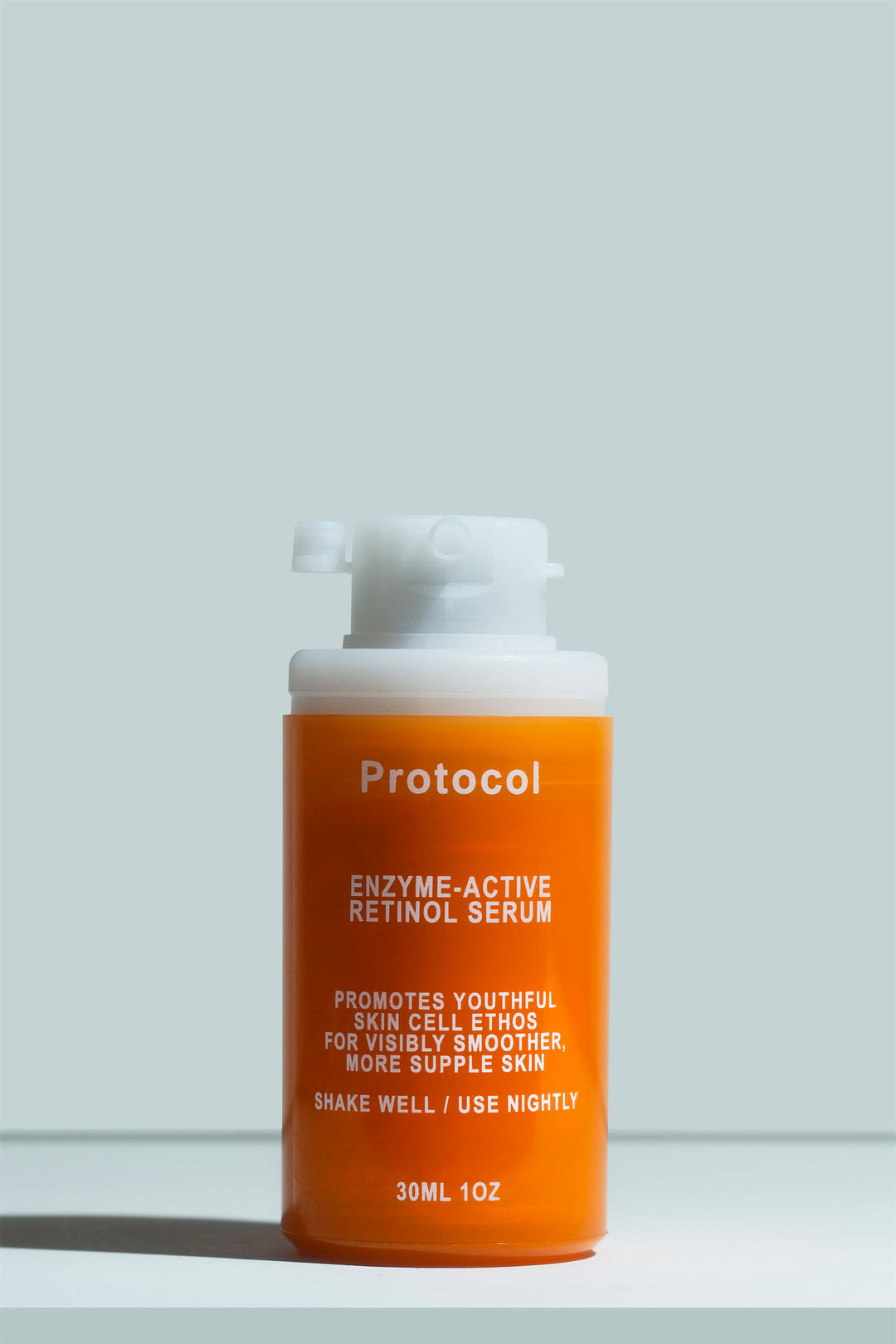How to Use Cleanser: A Complete Guide

We have some strong thoughts on how you should use cleanser correctly here at Protocol. Our ideas are rooted in the understanding that aggressive cleansing can be very harmful to the skin. Gentle, intuitive cleansing is key to keeping your skin looking fresh, healthy, and strong.
In this guide, we explain how to use cleanser step-by-step and in simple terms. Then, we’ll answer some of the most common cleansing questions, like how much cleanser to use, how often you should cleanse, and more.
Why you want to use cleanser correctly
The upper layers of our epidermis function best when they have a strong barrier. That barrier relies on a mortar of lipids and proteins that keep moisture inside the skin and harmful pathogens outside.
When too much debris and bacteria collect on the surface of the skin, that barrier can become compromised, resulting in skin infections and irritation. At the same time, if you cleanse too often or use a product that is too harsh, that can damage your skin barrier as well. That’s why cleansing the skin is so important, but also why it should be done carefully and not too often.
How to use cleanser (foaming or gel)
Most skincare enthusiasts use foaming cleansers with gel, cream, or mousse formulas with mild low-pH formulas, to keep the skin intact. Here’s how to use them!
- Splash your face with water.
- Apply the cleanser in your palm, and either foam up with your hands and a bit of water or apply to your face directly.
- Massage in circular motions, adjusting your pressure so that the cleansing process feels good.
- Spend a little more time cleansing creases like the sides of the nose or along your hairline, where oils and sunscreen can often get trapped.
- Be careful around the eye area — some cleansers can be used around the eyes, while others should be kept away. If you’re using our exfoliating AHA cleanser, we recommend you avoid using it around the eyes unless you’re an advanced skincare user.
- Once you’ve finished massaging your entire face and you feel like all debris has broken down, you can rinse away the cleanser.
- To rinse, splash your face with water repeatedly or place your face under the faucet if you’re in the shower. Remove all cleanser residue since leaving any on the skin can lead to irritation.
- You can also use a cotton sponge or damp washcloth to remove the cleanser. Just be careful with your pressure and avoid rubbing, as you may irritate your face.
- Leave your skin damp before layering on leave-on skincare products such as serums or moisturizers.
If you’re interested in double-cleansing or makeup removal, you’d do all of this after using makeup remover or cleansing with an oil or balm cleanser (which we explain in more detail below).
How to use oil and balm cleansers
Using oil and balm cleansers (as well as cold creams) is a little different from using traditional surfactant-based cleansers. These cleansers are excellent for removing very water-resistant sunscreen or long-wear makeup, but getting the most out of them calls for a slightly different process.
-
Start with dry skin. Adding water too early may interfere with the oil cleanser or cause it to emulsify before it can dissolve the impurities on your skin.
- Dispense a respectable amount of cleanser in the palm of your hand
- Massage into skin (no water should be involved in any part of the process)
- Slowly massage, allowing makeup and sunscreen to dissolve. If using it to remove waterproof makeup, let it sit for 5-10 seconds before massaging further.
- Once you feel like everything has broken down, splash your face with water and massage to emulsify your cleanser. Do this after 15 seconds to two minutes, depending on whether you have makeup or persistent sunscreen on.
- Finally, rinse away the emulsified cleanser with several splashes of warm (not hot) water.
- If you use a makeup remover, cold cream, or non-emulsifying oil cleanser, don’t splash your face with water, and wipe everything away with a soft, damp cloth or cotton pad instead.
- Finally, depending on your skin type and cleanser formula, you can cleanse again with a foaming cleanser.
Face wash problem-solving tips
From choosing the right cleanser to avoiding a mess, here are some of our favorite skin cleansing tips!
- Opt for a foaming cleanser if you have oily or combination skin. Made with synthetic detergents that bind oil to water, foaming cleansers remove oils, grime, daily sunscreen, and light makeup from the skin. In the past, foaming cleansers were quite stripping, but today many formulas cleanse well while keeping the skin barrier intact.
- For dry skin or makeup, choose oil and balm cleansers. These lipid-based cleansers rely on oils to break down other oil-like substances. They’re incredibly effective at dissolving the film formers often used in sunscreens or the waxes and oils in mascaras and other types of waterproof makes.
- Don’t cleanse with soap bars or other types of soap-based cleansers (such as liquid castile soap), as they are often drying and irritating to the skin, with a barrier-disruptive pH.
- Hop in the shower for an easier and less messy cleansing process.
- It’s become trendy to cleanse for a full minute, but this isn’t always necessary. Take your time and make sure you break down all impurities on your skin, but don’t feel obligated to cleanse for a full minute. 15-20 seconds are perfectly sufficient for routine cleansing.
- As you massage your face with cleanser, make sure your hands are gliding over the skin easily, without any rubbing. Any pulling or friction can irritate your skin.
- Pay attention to how your skin feels when you finish — your face should never feel tight after cleansing.
- When washing at the sink, use a headband to keep your hair out of your face.
- You can also use sweatbands on your wrists to prevent water from dripping down your elbows.
- For a more eco-friendly skincare routine, avoid disposable cotton rounds or wipes! Use facecloths and reusable pads instead.
How often should I wash my face?
This is where our beliefs at Protocol Lab are a little controversial. We think most people should only use a facial cleanser at night. Those with oily or acne-prone skin may wish to cleanse in the morning as well, while those with very sensitive or dry skin shouldn’t necessarily cleanse every night.
Research shows that cleansing your face more than twice a day can be actively harmful, contributing to acne breakouts and irritation.
We believe that your skin’s natural defenses, especially its intracellular lipids and microbiome, are perfectly capable of limiting the growth of harmful bacteria and keeping pathogens on the outside.
Over-cleansing can disrupt those natural defenses, increasing your risk of irritation or infection. On the other hand, not cleansing at all can cause similar issues, which is why it’s key to cleanse at the right frequency (which is different from person to person and even product to product).
So our bottom line here is that you should never wash your face more than twice a day, even if you have oily or acne-prone skin. If your skin is dry or sensitive, washing your face once a day (or even every other day) is enough.
How much cleanser should I use?
The exact amount of cleanser you need depends on what kind of cleanser you use and what level of cleansing your skin needs. With our AHA cleanser from Protocol, for instance, one pump is usually enough to cleanse the face and neck.
On a light sunscreen day, a pea-sized quantity of cleanser might be enough. On the other hand, on a day when you wear a full face of makeup, you may need double that quantity.
Another factor is how much your cleanser of choice foams up — you might need to use more of a creamy, non-foaming cleanser vs a gel that foams up dramatically. In general, it’s better to start with a smaller amount, and only add a little more if you feel like you don’t have enough slip.
Discover the most purifying facial cleanser
So that’s it for our take on how you should cleanse. It needs to be a gentle process that leaves your skin feeling great — anything else can mean damage!
At the Protocol Lab, we didn’t feel the need to create a simple, straightforward cleanser. While this wasn’t the case a decade ago, there are plenty of gentle, effective drugstore cleansers today.
Instead, we set out to create a transformative cleanser that purifies and renews the skin, amplifying the results of our full Advanced Renewing Line.
Our Alpha Hydroxy Acid Cleanser is a gentle chemical exfoliant and cleanser in one, made with two types of AHA. It clears away the rough surface layers of dead skin, leaving the fresh, youthful skin below perfectly intact. Also made with aloe and green tea, it hydrates and soothes the skin.
It’s best to use our cleanser to remove light sunscreen. It can also work well as a second step in a double-cleansing routine. The light gel formula foams up slightly, so all you need to do is follow our main instructions on how to use cleansers!
If you’re dealing with dead skin buildup, flakiness, signs of premature aging, clogged pores, or textured skin, introduce it into your routine as a more advanced way of cleansing.




